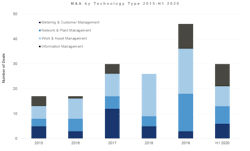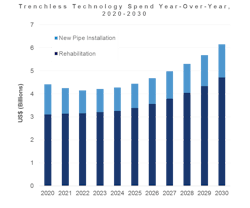This is no doubt a challenging time for the municipal water sector. Since March 2020, the world has been faced with quarantines, high unemployment, and an uncertain political climate. According to Bluefield’s revised forecasts, we expect a 21 percent decline in municipal capital expenditures (CAPEX) over the next five years in the United States alone. The recent fallout has led to changes in consumer behaviors, company operations, and strategic planning overnight. As a result, the water industry is compelled to pivot toward more resilient services, solutions, and sectors.
Of course, there is a lot that remains to be seen and 2021 will no doubt be unprecedented. In the U.S., we await the final outcome of Congressional elections, global availability and distribution of vaccines, and signals for an economic recovery. Bluefield’s water experts continue to track key economic indicators and company performance across the water sector. Here are a few of the top trends we are watching across municipal water.
Digital moves to the forefront of water strategies, creating shifts in the competitive landscape. Once again, Bluefield has highlighted the digital water market as the fastest growing and highest opportunity space within the water sector, even in light of the pandemic. Total expenditures on digital water hardware, software, and services will expand at a CAGR of 6.5 percent (from US$5.4 billion in 2019 to US$10.8 billion in 2030). There will be some top-line contraction in the short term which will be driven primarily by declines in capital- and labor-intensive, hardware-centric segments. However, growth in remote workforce and asset management solutions are expected to surge in the aftermath of this downturn.
Platform players, in particular, are well positioned. Platform players are the “big fish” of the water sector and the main players to watch as the industry continues to grow and evolve. Not only are these larger, diversified companies likely to benefit from utility and municipal confidence in their more established financial positions, they are also the ones to acquire the smaller players. But even this subsegment of the company landscape is changing with outsiders considering water an opportunity. For this reason, Bluefield is keenly interested in the role of private equity, “Big Tech,” and critical infrastructure firms who are seeking ways to enter, if not disrupt, traditional business models in water.
New business models are expanding the customer base for digital water solutions. From Software-as-a-Service to Data-as-a-Service, cloud computing and managed service models are increasingly placing digital technologies into the hands of small to mid-sized utilities. Companies like Aquify, Trimble, KETOS, and Kando, among others, have introduced innovative service offerings and pricing models that are better aligned with the budgets and technical capabilities of smaller utility providers. Business interest in the more than 400 very large utilities in the U.S. is expected to further transition toward a larger area of need (and opportunity) in smaller, tier 2 and 3 systems.
Engineering Consultancies (EPCs) prioritizing digital water. In response to the shifting landscape, EPCs are taking on new roles as digital water solutions providers, offering implementation and integration services and, in some cases, selling in-house software directly to utility and industrial end users. Often considered a gatekeeper to municipal utility opportunities, EPCs are leveraging their industry expertise and close customer relationships to move up and down the value chain, from design, procurement and implementation to change management, cybersecurity, and software development. At the forefront are firms like Jacobs, AECOM, Black & Veatch, Arcadis, and Tetra Tech, who are carving out distinctive strategic positions.
Private equity evaluates water sector for growth. A combination of resiliency and need for investment is attracting investment interest from private equity firms. Several reported and expected divestments, including Veolia North America, Synagro, and Innovyze, have created a buzz. These companies have solid platform positions into which other acquisitions can be added going forward.
At the same time, the pandemic will likely usher in a buyer’s market in the digital water start-up space, as acute cash flow crunches and short-term declines in venture funding put greater pressure on founders to find alternative sources of capital — and thus to sell their companies more cheaply than they otherwise would.
Pressure on utilities’ bottom line will lead to a shift toward third-party services. The COVID-19-related economic downturn is already leaving municipalities financially strapped due largely to declining tax revenues.
As a result, reliance on third-party services and contract operations is expected to accelerate as utilities place greater emphasis on operating costs, resiliency, and technology adoption. Smaller utilities will be most impacted by economic stress and will be more likely to look to contract operators for cost savings, redundancy in operational staffing, and new technologies.
Companies turn to alternative solutions to address age-old infrastructure issues. With over 2.2 million miles of drinking water pipe and 1.8 million miles of wastewater pipe, addressing aging water infrastructure continues to be one the most pressing issues facing the municipal water sector. The scale of investment required necessitates prioritizing rehabilitation of these aging assets and is expected to usher in more advanced asset management, such as predictive analytics. And in some cases, the opportunities for private investment, or investor-owned utilities, will increase because of these escalating costs.
One example, particularly in urban areas, are trenchless technologies. They offer municipalities shorter project timelines and significantly reduced surface disruption which result in lower overall project costs. Bluefield forecasts trenchless technologies will exceed US$52.5 billion over the next decade. The lion’s share (76 percent) of this spend will focus on rehabilitation of underground assets.
The pipe market will see a shift in material types. We will likely see a shift from traditional, legacy materials, like ductile iron and steel, to newer materials, including prestressed concrete and various plastics — PVC, HDPE, and PE. Plastic pipes account for 75 percent of the forecasted material used in pipe rehabilitation and repair projects as plastic vendors benefit from their preference in trenchless applications.
COVID-19 provides a catalyst for change, including new technologies. Solutions and technologies are becoming more sophisticated and have more applications in the water sector. One notable example is wastewater-based epidemiology. Limited understanding of the pandemic has brought wastewater treatment to the public’s attention and these technologies are not limited to coronavirus. Similar applications could go beyond COVID-19 to address opioid use and other health-related risks. WW
About the Author: Reese Tisdale is the president of Bluefield Research and has an extensive background in industry research, strategic advisory, and environmental consulting in the water, power, and energy industries. Prior to co-founding Bluefield, Tisdale was research director for IHS Emerging Energy Research, a leading research and advisory firm focused on renewable energy. He also has demonstrated experience in groundwater remediation for oil and gas companies and as an international market analyst for Thermo Fisher Scientific.





